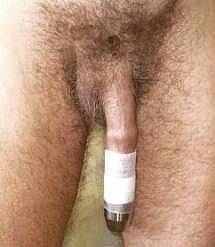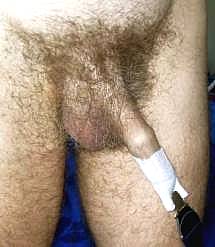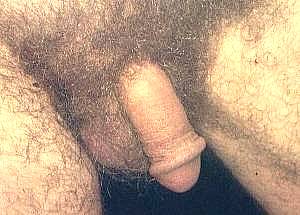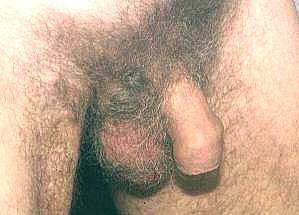|
||||||||||||||
|
Foreskin restoration Written by Dave, who restored his foreskin as shown here:
What is a foreskin? The foreskin (or “prepuce”, to use the medical terminology) is the protective skin sheath that covers the glans or head of the flaccid penis. This sheath contains specialized erogenous nerve endings and tissue which moisturize and protect the most sensitive parts of the penis. When the penis becomes erect, the foreskin slides back to expose the glans. Except in rare cases of penile abnormality, every human male is born with a foreskin. Circumcision removes this protective sheath, with its most sensitive inner surface, leaving the glans exposed at all times. If your glans is normally covered by this skin sheath, you have a foreskin. If the glans of your penis is always bare, then you have no foreskin.
Foreskin restoration sounds bizarre. Is it some kind of medical procedure? It only sounds bizarre if you've never heard of it. If you'd lost a finger or foot early in life, surely you'd want to try and replace the function of the body part as much as possible. Restoring your foreskin is no different. The foreskin restoration techniques described here are non-surgical, and involve stretching the penile shaft skin out over time to form a replacement foreskin. The process costs very little: mostly it just takes time and patience. At least several thousand men have completed this process or are presently doing it. Is it some kind of gay thing? There are gay men doing foreskin restoration as well as many straight men. But the desire to restore the function of a missing or damaged body part isn't related to sexual orientation, ethnic origin, moral values, or religion. And does it really work? Yes! It definitely works if you have the time and patience, since it is a gradual process. Most people wouldn't be able to distinguish between my restored foreskin and a natural foreskin. My experience and pictures are included below. Restoring a foreskin can take from about a year to more than six years, depending on the tightness of a man's original circumcision, the stretch ability of his skin, his age and physical condition, and the stretching methods he uses. Foreskin restoration can have many benefits, including allowing the remains of the inner foreskin and glans to revert to naturally-occurring mucous membranes, but it cannot restore all the nerves, blood vessels, the sensitive frenulum, and the inner ridged mucosa lost during circumcision. Since this restoration page is in part my personal story, my progress photos and story are shown in a later section. Why would a man want to restore his foreskin? For me, the main reason was the low sensitivity of my penis, apparently caused by my very tight circumcision as a newborn, which destroyed virtually all of my sensitive inner foreskin. I've been this way for as long as I can remember. Such insensitivity necessitated a lengthy build-up to orgasm – in fact, sometimes it was so long that I couldn't actually get there. Even as a horny teenager, I can remember some occasions when I got very sore from trying for an orgasm during masturbation. You'll find very little information about delayed ejaculation on the internet, and I have personally found nothing relating to low penile sensitivity. Editor's note - if any man would care to email me with reports of changes in penile sensitivity after restoration of his foreskin (for example, as measured by lasting longer during sex) I would be very pleased to hear about it. moreinfo @ the-penis.com - remove the spaces... I thought it was just me. Then after I turned 50, my sensitivity deteriorated further, to the point where I was becoming sexually non-functional. I could get an erection, but I just couldn't generate enough stimulation to reach orgasm. An enlightened urologist introduced me to foreskin restoration because he thought it might help my sensitivity. It did, and I am fully sexually functional today, following restoration. Even though things are not perfect, they are certainly much improved. Then there were two other problems which I didn't recognize as reasons for restoration until I'd successfully completed it. First, all of my life my glans had rubbed uncomfortably and sometimes painfully against my underwear – especially when I did athletic activity. Nothing helped: I tried double jock straps, stuffing with toilet paper, wrapping with Seran-wrap, even wearing a condom. Now, with a comfortable, protective foreskin, that problem has completely disappeared! Second: I was circumcised very tightly, so that the shaft skin was nearly drum-tight when my penis was erect. Sometimes during sex, the tight shaft skin pulled up my scrotum so much that my testicles would get “stuck” against my body and then squashed, which meant I had to stop sex so I could try to massage them back down. This has never happened since I restored my foreskin. Other men have different reasons for
restoring their foreskin, but rather than try to list all of them, you can draw
your own conclusions by clicking here for If you want to learn more about the anatomy of the penis and intact foreskin, go to the anatomy and circumcision page of this website. Background to foreskin restoration Foreskin restoration has actually been going on for literally thousands of years. During the original Olympic Games, participants competed in the nude, and the games could be observed only by males. Jewish athletes, who had been circumcised (but not nearly so closely as today), were banned from the games because their penises sometimes showed an exposed glans. This was considered to be indecent, since an exposed glans was an indication of sexual arousal. Jewish athletes figured out that they could stretch their short foreskins to fully cover their glans and be allowed to compete. Unfortunately, in about 140 AD the ruling Rabbis decided to enforce a much more drastic circumcision so that Jews could not masquerade as non-Jews. As it turns out, today's circumcision resembles this later, more drastic form of foreskin amputation. Today, there are several thousand men who are actively restoring or have completed their restoration. There are numerous networking and support groups for restorers, as well as other printed and web-based resources (discussed below). But don't expect your doctor to be much help in this endeavor. Most doctors have never heard of it. They may well tell you that it cannot be done, or that it will make no difference to sexual function, or that it cannot improve sensitivity. And in the USA the chances are high that a doctor will himself have been circumcised just after birth, so he may never have considered, much less felt, the advantages of a foreskin. The USA is the only advanced country where doctors still practice circumcision for “medical purposes”: approximately 60% of all newborn males are circumcised in the USA today, down from about 90% in the 1970's. However, in recent years, the American Academy of Pediatrics has said that the potential medical advantages do not exceed the risks of the procedure. If you further consider the loss of functionality imposed by removing a healthy and important part of a healthy organ, you can begin to see why there is considerable interest in restoring it. How does non-surgical foreskin restoration work? By gradually lengthening the skin on the shaft of the penis through a slow “stretching” process. This is a technique that encourages the skin to actually expand in the direction of the stretching. The concept is really no different from using skin stretching to cover burned or wounded areas of the skin, or when skin naturally stretches to accommodate a weight gain or increase in body size. However, because the penile skin is multilayered and contains a special facia, (which is tendon-like tissue), it takes longer to expand than normal body skin which does not have that facia. The penile skin is, in effect, a tube of tissue covering the internal cylindrical shape of the penile shaft. The skin tube is attached at both ends, from the base adjoining the body, to the end of the penis just under the glans, or head. Between the attached ends, the penile skin is not connected to the underlying structure. It is therefore mobile and floats over the enclosed shaft much like the eyelid floats over the eye. The skin tube in its natural shape normally is longer than the internal shaft it covers, and extends forward of the glans as the foreskin. Foreskin restoration methods seek to apply lengthening tension to the skin along the length of the penis. There are only two directions this tensioning can be applied to encourage lengthwise growth of the penile skin: either away from the body, or toward the body, or a combination of both directions at the same time. The majority of restoration methods use tension, or tugging, the skin away from the body. When you start to restore your foreskin, there's often a fairly quick initial expansion, but this is just temporary stretching of the skin. Long-term lengthening is the result of new tissue cells growing in the direction of the tension. The growth of these new cells eventually yields a lengthened foreskin. This process is a gradual one. It can take between a year and several years to accomplish the desired result. In my case (described below) it took six years, but a typical length of time is 2 to 3 years of applying tension using any of a variety of methods. The newly-grown foreskin is permanent, and will not diminish over time. The time required for a final result varies for many reasons. It depends on the tightness of the circumcision, the stretch ability of the skin, the age and physical condition of the individual, and the stretching methods used. Foreskin restoration generates a foreskin which will provide a protective sheath over the glans and remnants of the original inner foreskin, and allow these areas to return to mucosal tissue. It cannot, as previously mentioned, restore all the nerves, the blood vessels, the sensitive frenulum and the sensitive inner ridged band of the original intact foreskin. Nevertheless, with rare exceptions, men who have completed their foreskin restoration are pleased with the result. Getting started Deciding that it's worth the effort and then making the commitment to actually do it may be the hardest part of the process. There are a number of websites with information, and several books listed below, as you read on. Probably the best resource for getting started is the book “The Joy of Uncircumcising”. Although this book is out of print it is available in libraries, through restoration websites and on eBay. Many of the ideas in the book are available on the internet, and are also described in the Resources Section of this page. The first step in restoring a foreskin is to gather a fold of penile shaft skin to stretch forward and hold in tension. This is true whether you simply use tape strips to hold the skin forward, or whether you are taping to some kind of weight or adapter to an elastic strap. The tighter the circumcision, the less skin you have to work with at the beginning. Most restorers begin with some sort of simple taping arrangement, until a little foreskin growth allows more options for taping to weights or elastic straps. Methods and techniques Most restoration methods utilize taping, often in combination with weights or elastic bands to provide tension. Information on purchasing the various products that are available is provided, with links, in the Support Groups and Resources section, below. The most common methods can be outlined as follows: Taping alone This method involves using small pieces of surgical tape to pull the shaft skin over the glans and hold it in position. If the shaft skin (foreskin remnant) is pulled up and over the glans, it can then be held there by strips of tape typically crisscrossing over the tip of the glans, to hold the skin forward. Tension is provided by the pull of the foreskin stretched over it. If you do not have enough skin to cover the glans, then it is necessary to provide a paper or cloth buffer over the bare part of the glans to prevent the tape sticking directly to the glans. This method works fairly well when starting, but does not have much tension. Once the foreskin begins to lengthen, even less tension is provided, and so most restorers move on to other methods fairly quickly. This and other starting methods are covered in great detail in the book "The Joy of Uncircumcising". You can find pictures and discussion about how to tape using the above techniques at https://adult.eskimo.com/~gburlin/restore/image.html . Weights Weights are either shaped to fit over the glans or are attached to a shaped adapter which fits over the glans. They are held on by pulling the shaft skin over the weight or adapter and taping it in place. The weight provides tension as long as it can hang freely. One type of specially-made weight, the PUD (Penis Uncircumcising Device), is cylindrical with a shaped indentation at one end to fit over the glans, and has a hole through the center to allow urination without untaping to remove the device. Film tubes or pill tubes 35 mm film or pill tubes are cylindrical containers. They can be selected in a size that just allows the flaccid glans to fit inside, and then modified for foreskin restoration. Usually, the closed end is removed and a tab or hook fashioned to allow it to be clipped to an elastic strap. Once the glans is slid into the tube, the shaft skin is then pulled over the outside, and taped to the tube, much in the same manner as the PUD, described above. Fabricated tape with attachment tab (called a “T-Tape”) This fabricated tape is quite popular with restorers. It is made by taking two pieces of surgical tape, typically about 2 inches wide and 6 inches long (length to match the circumference of your penis when erect), and putting them together, with facing adhesive sides along about half of the tape (that is, about 1 inch of the 2 inch width). Once fabricated, the tape is applied by wrapping the adhesive part to the “T” around the circumference of the erect penis, usually about 1 inch down from the edge of the glans. After the erection has subsided, the “tab” part of the tape can be gathered together, and clipped to a weight or elastic strap to provide tension. The two adhesive flaps of the tape (now stuck to the penis shaft skin) fold over to pull on both the “outer” and “inner” foreskin. The T-tape should be installed so that the center of the fabricated tape (described in the pictures below) is along the "line of equilibrium" on the skin of the penis shaft. Find that line by pulling the shaft skin forward on your flaccid penis as far as you can, making a fold at the outer-most end. Mark this point at the fold with a non-toxic felt-tipped pen and continue the circle around the circumference of your penis after releasing the foreskin. Then, when you install the T-tape on your penis, (you should have an erection or partial erection), center the tape at the marked "line of equilibrium". When you use the installed T-tape to provide pulling tension, it should pull equally on the inner and outer sides of foreskin. If you have already found and taped around the "line of equilibrium" and your inner foreskin (which is more sensitive that the outer foreskin) is hurting or uncomfortable, you may be pulling with too much tension. If so, then try to pull with less tension. Another solution is to move the "line of equilibrium" further down the shaft of the penis and away from the more sensitive inner foreskin (or foreskin scar after circumcision). That way when you pull the installed T-tape, it will pull a little harder on the outer skin, which is thicker and less sensitive than the inner foreskin. You could try moving the "line of equilibrium" down by about 50mm (1/4 inch), then if that is not enough another 50mm, and so on, until you find a more comfortable position. The six photographs below show the concept of fabricating, applying, and using the T-Tape. This T-tape was made using a single piece of 4-inch wide Hypafix tape about 5-1/2 inches long (rather than two pieces of 2-inch wide tape), which is folded over on itself to form the T-tape.
Additional detail for constructing
and applying T-tapes, is available at the T-Tape Picture Book Website:
Restoringmen.net There are several types of tape usually used in foreskin restoration. They are all medical or surgical tapes, and include: Micropore tape (3M Company), a paper-based medical tape, designed to stick well to the skin, widely available in drug stores. It comes in rolls 1-inch and 2-inches wide. This tape is inexpensive, but not as soft and durable when in place as surgical tapes. Hypafix (used in the above photo sequence) or Rejuveness tape, soft mesh-backed surgical tape, which is very soft and yet sticks very well to skin. These tapes are available in some surgical pharmacies, or can be ordered by phone or mail. These tapes come in widths of 2, 4, and 6 inches. For more information on purchasing these tapes, see the Support and Resources links below. Elastic straps for providing tension Elastic straps to provide tension require a clip at each end and preferably have some method of length adjustment. One end of the strap is clipped to the tape attached to the penis (such as the T-tape described above), and then wrapped around the waist, or down the leg around the calf or foot, or up over the neck, with the other end clipped back to the strap to form a loop. The strap over the neck works well at night, since it allows for nocturnal erections. These straps can be fabricated from elastic and clips found at sewing stores, or by separating suspenders (i.e. “braces” for the UK readers) into two ready-made restoration straps. The photos below show two of the methods of tugging discussed above, the PUD weight, and using the elastic strap for tension. Photo 1 shows a PUD taped on, providing downward tugging, in any position which allows the weight to hang freely. The PUD can be taped on with or without using a T-tape, but the photo shows the PUD which is taped to a T-tape. Photo 2 shows the use of an elastic strap, attached to a T-tape, and tugging down the leg. Other taping positions include up over the neck, or around the waist.
O-Rings O-rings are circular rings of rubber or elastic. When the perfect size is found, the shaft skin can be pulled over the glans, and the o-ring slipped over the skin over the glans. When the size is right, the o-ring will hold the skin, but will be too small to slide back over the glans, thereby holding the skin in place. This method does not provide much tension, and requires some slack skin to pull over the glans. Also it can be uncomfortable if the size of the o-ring is too restrictive, and should be used with care. Devices to grip the shaft skin There are several devices (typically shaped like a large nipple), which fit over the glans, and allow the shaft skin to be pulled over the nipple shape. A similar shape fits over the nipple and foreskin, and grips the foreskin without the need for tape. These devices also have an attachment tab, which allows a weight or elastic strap to be attached. For more information on purchasing these devices, see the Support Groups and Resources section, below. Packing inside the foreskin Any of the methods described above can be enhanced by increasing the tension on the foreskin with packing put inside the extended skin tube. Typically, spongy material is stuffed inside the space between the glans and the tugging device (a PUD, film tube, or inside the T-tape). The spongy material provides compression against the glans, pulling against the extended foreskin, and providing added tension. Some restorers find this pressure against the glans to be quite uncomfortable, while other restorers testify to improved results. Manual stretching If you do not want to be bothered with any device, you can do restoration with manual stretching. That is, by manually pulling out on the shaft skin to put tension on it. This would be difficult to do if you have very little shaft skin, and you would have to spend many hours manually pulling to have an effect. The methods and techniques listed above are a sampling of a nearly infinite number of ways to use tape, weights, tubes, packing inside the foreskin to increase tension, and devices to attach to the foreskin with or without tape. Some of these devices are referenced below if you read on to the Support Groups and Resources section. Dave's experience – a personal account of foreskin restoration I've already listed my reasons for foreskin restoration. Just to recap, they were mainly to improve my sensitivity and also to alleviate the problems associated with my tight shaft skin, which was the result of my neo-natal circumcision. I started by using a PUD. However, I did not have enough shaft skin to pull over the outside of the PUD in order to tape it on. The first few weeks of trying were frustrating, and caused soreness on my skin from the uneven tension and the tape pulling off unevenly. Taping would sometimes last only for a few minutes before pulling off. This was a problem I would have to solve before I could seriously begin restoration. In the Before photo below, you can see that I had a very thin circumcision scar, located right up against the glans – this is an indication of how much shaft skin had been taken when I was circumcised. Nevertheless, I started restoration with high hopes and great determination, which was severely tested in the first few weeks, until I found a way to comfortably tape and tug the shaft skin.
Then I figured out a solution, which used electrical “shrink-fit”, a tough, flexible plastic tube which can be shrunk over a shape with the use of a heat gun. (It's used in electrical work to shrink over electrical cables.) I shrunk it over the PUD, and then to an extended shape which would just fit my glans. Like a film tube, I could now insert my glans into it, pull my minimal shaft skin over it, and tape over the shrink-fit extension. That required all the slack shaft skin I had, which was about 1/4 inch folded over. It worked! And after a few months, I found that I had stretched the skin enough to give a little more slack for taping. This initial stretching success is typical in restoration, but unfortunately it is not permanent. The initially stretched skin will revert back if restoration is discontinued at this point, because initially the skin is only stretched - no new tissue cells have grown. It usually takes about six months to begin to see permanent tissue growth which will not revert back and is permanent. Restoration has taken me far longer than it does for most people - about 6 years - because of my circumcision was very tight and my skin had minimal stretch ability. The PUD with the extension was my only method of restoration for about four and a half years. The Midway photo below shows the progress I'd made in the first three years. It was definitely progress, but without a frenulum (which cannot be restored), the new foreskin would slip back off the glans after just a few minutes. In the last one and a half years, while restoring my foreskin to be long enough to fully cover my glans , I mainly used the T-tape, described above, clipped to an elastic strap, or sometimes taped to a PUD. The After photo shows the final result. I now have a glans 100% covered when flaccid. It will remain covered at room temperature, except during an erection. At higher temperatures, the foreskin will loosen up, and may slip back off the glans after a period. A small tab of tape on the underside of the foreskin near the tip of the glans will tighten it just enough, to prevent it from slipping back under any temperature conditions. Or if I wear brief-type underwear, the foreskin will never slip back. Now, after a 3 year hiatus in
restoring, I am back at it again, in the hope of growing an ”overhang”, or
foreskin that extends beyond the tip of the glans (as many natural foreskins
do). The advantage of an overhang is that it will tend to hold the foreskin in
place even under warmer conditions, and will therefore provide more comfort in
all situations. What am I using this time? I'm using T-tape, sometimes clipped
to a strap, and sometimes taped to a PUD.
Yes! In fact, I'd do it all over again if I had to. It does take time and patience, but over time, you get results. If restoring is too much of an inconvenience, you can always discontinue it until it is more convenient. That simply extends the time to get results. I have never spoken with a man who has completed restoration and says he wishes he hadn't done it. As I wrote at the beginning of this page, my gains were greater than I expected when I started the process: improved sensitivity, protection from rubbing of the naked glans especially during athletic activity, and less skin tension which results in more comfort on the penis and scrotum during erections and sexual activity. What can you expect from a transformed penis? Sex will most certainly be better than before. You will find that during intercourse, you can thrust much more gently to get the same stimulation, and a foreskin also makes it more comfortable for your partner. In fact, sometimes even just undulating your hips will provide enough vaginal stimulation on the penis. Many restored guys find they can masturbate through the foreskin, by stroking up and down on the outside foreskin, and being stimulated by the pressure and interaction of the inner foreskin and glans, with no lubricant required! Hygiene doesn't require much more attention, but it is a little different. To clean the newly restored penis, just peel your foreskin back in the shower and rinse it with water. Try not to use soap, but if you feel you must, find the gentlest soap you can, and then rinse it off completely. Soap tends to dry out the new mucous membranes under the foreskin, and can be an irritant to this sensitive tissue. If needed, you can moisturize the area under the foreskin with a little mild face cream. If you were circumcised very tightly, the natural glandular tissues in the foreskin that provide the natural lubrication were destroyed, and cannot be restored. This is described in the Functions of the foreskin page of this website. Foreskin behavior: keeping covered at all times. Once restored, you will probably wish to stay “covered” at all times except during sex. At night, nocturnal erections will usually cause the foreskin to slide back, and because the frenulum is missing, the foreskin may not recover after the erection. Dave uses a little O-ring made from a fabricated loop of the elastic you can buy in a sewing shop. It is sized so that it will fit over the foreskin forward of the glans and gently hold the foreskin forward, even during an erection. A small piece of tape across the underside of the foreskin near the tip will also gently assure the foreskin remains forward. During the day, wearing brief type underwear is usually enough to keep the restored foreskin covering the glans all the time, hot or cold, but at night might not suffice during erections. Aroma: You may have heard that uncircumcised penises (and it follows, restored penises) sometimes have an aroma associated with them. The inner foreskin of an intact (uncircumcised) penis has natural lubrication and natural “flora” of protective, beneficial bacteria, just as the female genital tract has. This may develop a slightly cheesy aroma if it builds up. Simply showering regularly, as discussed above, is usually enough to eliminate or minimize any odor. When you have vaginal intercourse, you do share beneficial bacteria with your partner. Now you have a protected mucosal area, it can flourish there as well. Yeast infections: If your female partner has a yeast infection, it is possible to get it under your foreskin. This is especially true if there is no natural bacterial flora already present. Before you are restored, yeast doesn't flourish very well on the dry skin of the circumcised penis, except within the urethra. With a foreskin, a yeast infection can produce redness and soreness on the glans and on the underside the foreskin. The simple solution: just use the anti-yeast treatments available for female yeast infections, and it will clear up quickly. Frequently asked questions Is restoration painful at all? It shouldn't be. In fact, a rule of restorers is that if you feel pain or even continuing discomfort, you should stop what you are doing, determine the problem, and make an adjustment. Things that can cause discomfort include tugging too hard, uneven taping, or constricting circulation in any way. Can you harm yourself in doing foreskin restoration? You cannot harm yourself with foreskin restoration as long as you abide by the guidelines in the section about discomfort immediately above. About the worst injuries you can get from non-surgical restoration are occasional pinch marks (from taping too tightly or using tape which is too stiff), or skin soreness and microscopic tears when tugging too hard or unevenly. Does restoration reduce sex? Restoration only reduces the spontaneity of sex because of being taped much of the time during the process. The key is to synchronize your taped / untaped periods with your sexual activity. Once the foreskin is restored, or even partially restored, sex tends to improve because of the increased sensitivity from the protected inner foreskin and glans, and the “gliding” action of the foreskin during sex. This may, of course, lead to more sex rather than less! How fast will I see results? Usually you will see some stretching of the foreskin after 3-4 months of tugging, depending on the methods used. But this initial stretching is just that - stretching of the skin cells, not growth of cells, and it won't last if you discontinue restoring. Longer term restoration results (6-12 months) are actually the result of the growth of new tissue cells, and are permanent. When you stop restoration, this new tissue growth will stay with you. Does restoration limit exercise? Restoration will not limit your life in any way if you don't want it to. Obviously, wearing weights during a workout doesn't work well, but replacing the weights with an elastic strap allows you to restore while you exercise. You can even swim while taped up. Can I take a shower or swim while still taped up? You can take a shower or swim without removing, for example, a T-tape, which usually lasts 3-5 days. Don't try to tug while the tape is wet, since it does not adhere as well when wet. Using a hair dryer to dry out the tape afterward quickly restores the tape's normal adhesion, and allows a return to tugging. Hypafix or Rejuveness surgical tapes (described above) seem to have better moisture resistance. A latex condom can be helpful in keeping the taped area dry during a shower, requiring little or no drying afterwards. If I am intact with a short foreskin, can I use restoration techniques to lengthen my foreskin? Foreskin restoration methods work just as well for an intact man trying to gain foreskin length as for a circumcised man restoring - in fact probably better because he has much more skin to work with. However, it would be best to use those taping methods which do not put tape on the sensitive, delicate inner foreskin (such as taping to a PUD or film tube rather than T-taping). Also, because the natural foreskin is usually thinner than the shaft skin taped during circumcised foreskin restoration, you would probably be advised to use less tugging tension. Books applicable to restoration The Joy of Uncircumcising, by Jim Bigelow, Ph.D., ISBN 0-934061-22-X , the "restorer's bible”. NOTE: This book is currently out of print. It can be purchased through the National Organization of Restoring Men, at a price of $25 for the book, or $10 for a An Adobe eBook (PDF) version. It is also available in some libraries, and can be purchased from Amazon.com or eBay, usually for a considerable premium from the original $19.95 purchase price. Circumcision: A Jewish
Perspective, by Ronald Goldman, ISBN 0-9644895-6-2. Support groups and resources for the restorer Restore List The Restore List is a private e-mail restoration forum, where restorers can discuss methods, ask questions of other restorers, and share common problems. The normal version forwards all messages to your e-mail address. The Digest edition combines the e-mail messages for the day and sends them to your e-mail address. To join The Restore List, follow the directions as follows: To subscribe, simply send an e-mail
message with the word "subscribe" in the Subject field to:
For the digest version, instead send
the message to: If you wish to state your interest in joining the list, you can explain in the body of the e-mail, but each line must begin with a dash (-), or it will not be read. Circumcision and Information Resource
Pages (CIRP) The CIRP website has an extensive library relating to all aspects of circumcision and foreskin restoration. It also provides extensive links for all its subject areas, and often has links to the originators of the library items. National Organization of Restoring Men
(N.O.R.M.) Information and links to other information sources for those interested in foreskin restoration. InfoCirc is located in Montreal . Restoration Equipment and methods
comparison table This web page provides a matrix type table, which evaluates different restoration methods and types of restoration equipment, with various factors to give you an idea of what works for your particular situation and life-style. Sources of foreskin restoration equipment NOCIRC of Michigan This circumcision information organization provides a ?starter kit? for new restorers. All the materials you need to start restoring come with this kit, including special tape, scissors, clips, elastic straps, and an illustrated instruction guide on how to fabricate T-tapes. NORM Information
page on restoration devices This web page briefly describes all the common devices used in foreskin restoration, along with pictures and links. Foreskin restoration Maker of the PUD (Penis Uncircumcising Device) TLC Tugger This is a tapeless silicon device with an inner cone extending to an attachment tab, and outer hollow cone. The foreskin is pulled over the inner cone, and the outer hollow cone slid over the foreskin. When tension is applied to the extended tab of the inner cone, the combination will hold the foreskin under tension without tape. The outer cone can be bought separately and used as a night-time retainer, similar to an o-ring, once there is enough foreskin to cover the glans. Restoring Foreskin.org https://www.restoringforeskin.org RestoringForeskin.org is a social networking site for those men who wish to participate in a community devoted to foreskin restoration. The site welcomes those who wish to learn how to restore foreskin and undo the effects of circumcision, and also includes those who wish to advocate against routine infant circumcision (RIC) and seek ways of being an intactivist. Members can participate in foreskin restoration blogs, a foreskin restorating forum, member polls, member albums, several chat rooms, and a private messaging system. Recap E-Z Recap E-Z is a device for holding restoration tension, without tape, weights, or straps. The device fits over the penis shaft, and applies tension over an extension which is about 8 inches long and rests against the pelvic bone. As with the Tug-Ahoy, the device works best if some restoration has already been accomplished. You can contact the manufacturer Arthur Gibson. Allegro Medical Hypafix tape is distributed by BSN Medical, who can tell you where to find it. It is available in rolls of 10 yards long, 2-inch, 4-inch or 6-inch widths. Call 800-876-1261. Or you can buy it on-line at Allegro Medical, using the search word "Hypafix". ReJuveness Tape This tape is virtually identical to Hypafix, but is available only in 2-inch width. On the website, look under the "Scar Healing" tab, then look for Rejuveness Medical Tape. If you would like
to contact Dave about his restoration experiences, equipment
used, or how to fabricate tape and O-rings, you may contact him by e-mail by
clicking
|












